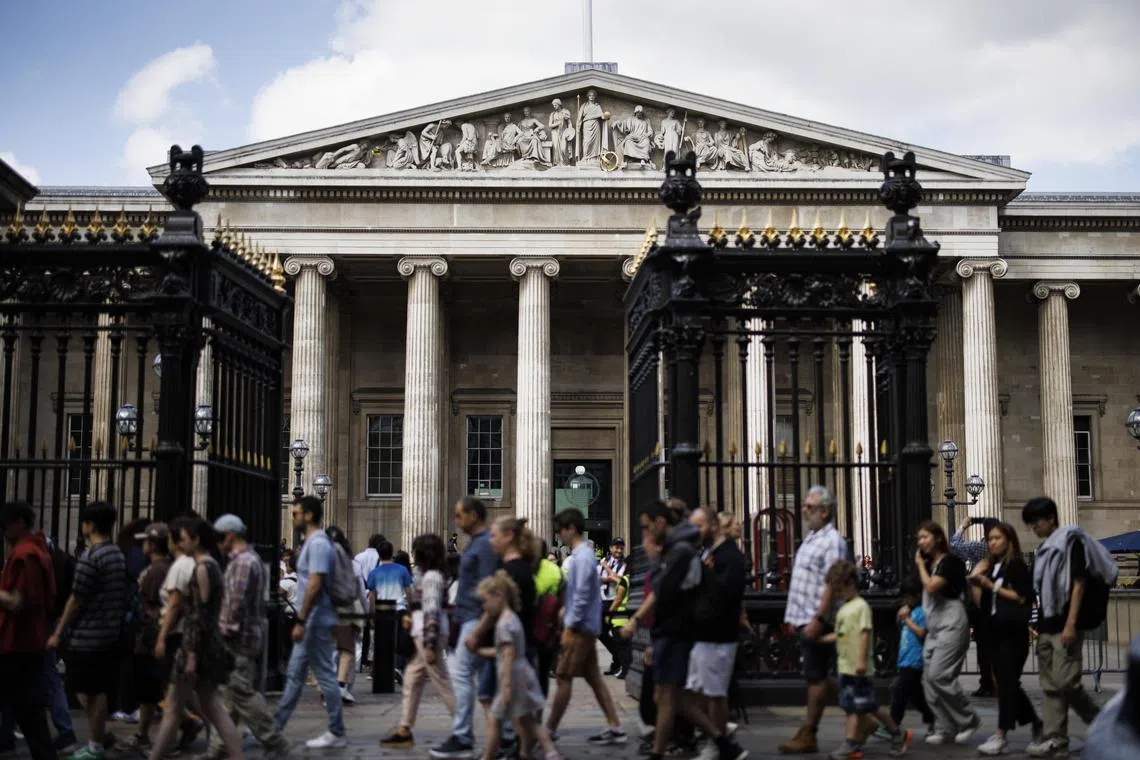British Museum was warned gems were being sold on eBay, emails show
Sign up now: Get ST's newsletters delivered to your inbox

The thief must have been someone inside the institution, said a dealer in ancient gems in an email to the museum.
PHOTO: EPA-EFE
Follow topic:
LONDON – In 2021, British Museum officials were alerted to a potential thief in their ranks.
That year, Mr Ittai Gradel, a Denmark-based dealer in ancient gems, contacted the august London institution with evidence that he said showed that three gems from the museum’s collections had been offered for sale on eBay.
Museum officials were aware that something was up with one of those artifacts. Another dealer, Malcolm Hay, had gotten in touch to say he had bought one of the gems but was concerned it was stolen. He returned the jewel to the museum in May 2021.
The thief must have been someone inside the institution, Mr Gradel said in an email to the British Museum that has been obtained by the The New York Times. He was concerned, he added, that the three gems were “only the tip of a much larger iceberg”.
The British Museum opened an investigation that reached a swift conclusion, according to correspondence seen by the Times: That nothing untoward had happened.
Mr Jonathan Williams, a deputy director at the museum, said in an email to Mr Gradel that “the objects concerned are all accounted for and with no suggestion of any wrongdoing on behalf of any member of museum staff.”
In October 2022, Hartwig Fischer, the museum’s director, told a trustee that the matter was closed, according to the correspondence. Mr Gradel and Mr Hay declined to comment for this article.
Now that decision appears to be coming back to haunt the museum.
Last week, the British Museum said in a news release that it had fired an unidentified staff member
London’s police force said it was investigating.
A museum spokesman declined at that time to say how many items were involved while the police investigation was ongoing, but the news release said that the stolen or damaged items included gold jewellery and “gems of semiprecious stones and glass,” some dating as far back as the 15th century BC.
On Tuesday, another spokesman declined to comment on the museum’s 2021 investigation.
“This is all now subject to the independent review and also the police investigation, so we can’t comment further at this point,” she said in an email.
London’s police force said in a statement on Tuesday that it had not made any arrests in the case.
In the week since the news of the thefts broke, the case has been the subject of heated speculation in the British news media, with daily articles conjecturing over how many artifacts had been lost, and who was responsible.
Professor Erin Thompson, a specialist in art crime at John Jay College of Criminal Justice in New York, said it was unusual for a major museum to go public with details of internal losses.
“Normally, it’s kept under wraps,” she said.
She said she hoped that other museums would follow the British Museum’s example and be more open in future.
Other experts said the museum should have acted more quickly.
Mr Dick Ellis, the former head of Scotland Yard’s art and antiquities squad, said he was shocked the museum appeared to take so little action in the two years since the alarm was raised.
To uncover what had happened, Mr Ellis said, the British Museum would first need to ascertain what exactly had gone missing; then police would need to get records from eBay or other auction sites to ascertain details about any completed or attempted sales.
Then, Mr Ellis added, police would need to contact the items’ buyers. If any buyers were based outside Britain, that could hamper inquiries.
Some similar investigations have lasted years without coming to a resolution.
In 2020, Dirk Obbink, a former University of Oxford scholar, was arrested on suspicion of stealing and selling ancient papyri.
He was released without charges as the Thames Valley Police continued to investigate, and a spokesperson said this week that there had been no recent advancements in the case.
Last week, the British Museum announced a new independent review, led by Mr Nigel Boardman, a former museum trustee, and Ms Lucy D’Orsi, a British police official, to look into the thefts and make recommendations regarding future security arrangements.
The British Museum spokesman said the organisation would publish the results of the review, which is scheduled to be completed this year.
The museum is also looking to recover all the lost items. Mr Ellis said that could be difficult if the artifacts were sold years ago and had passed through several hands.
“I have sympathy for the museum, having to look after a collection this size,” Mr Ellis said. But, he added, “it is the museum’s responsibility to do so.” NYTIMES

